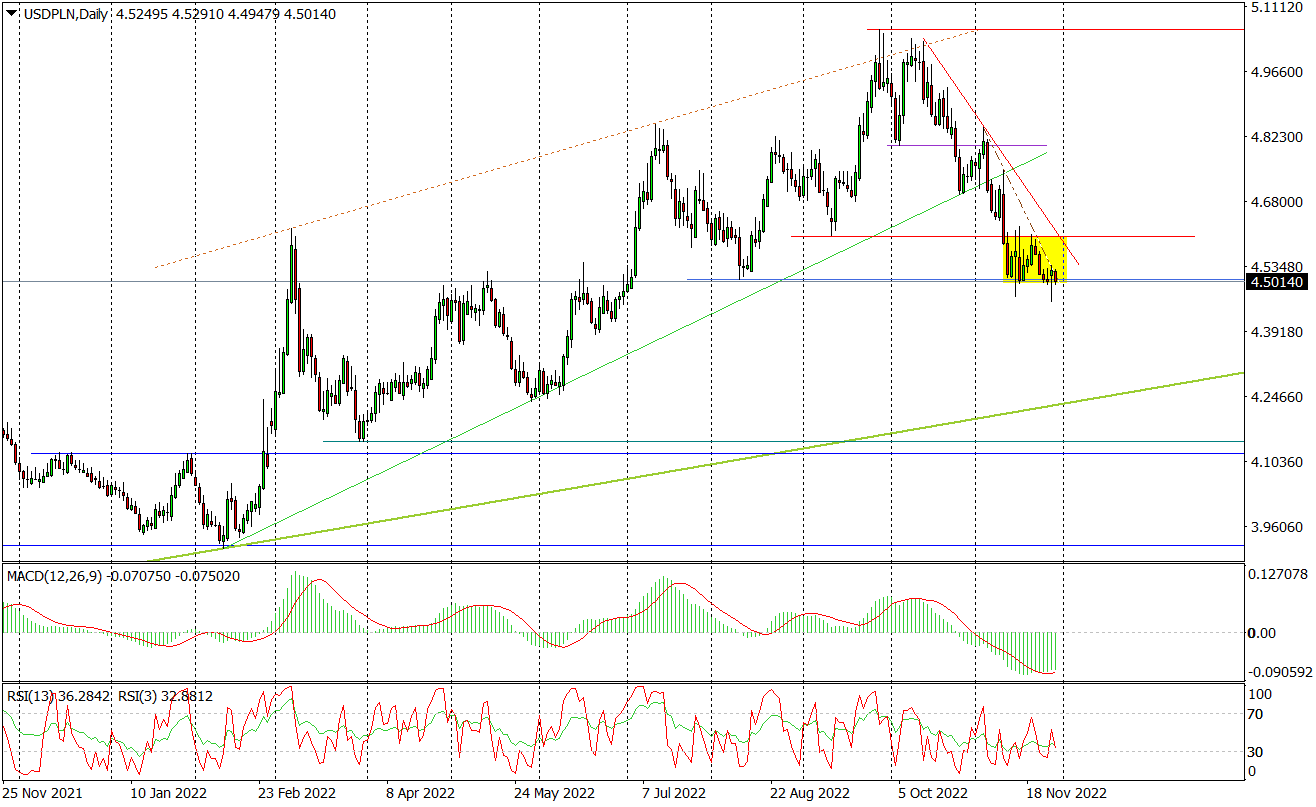Falling inflation in Europe supported the zloty
The zloty is strengthening against the main currencies, supported by hopes for an inflationary turnaround in Europe. In the second half of the week, the fate of the domestic currency will depend on data from the US labor market.
PLN gains thanks to data from Europe
The zloty strengthens against major currencies on Tuesday. In the afternoon, the euro traded at PLN 4,6723, the dollar fell to PLN 4,5014 and the Swiss franc fell to PLN 4,7404.
Polish currency appreciates today after yesterday's attempt to strengthen it was abruptly interrupted by a strong return of quotations EUR / USD and deterioration of the investment climate in global markets.

USD / PLN daily chart. Source: Tickmill
Later in the week the zloty may show a tendency to strengthen further, supported mainly by positive news from the world's major economies. The first such information has already appeared. This is the drop in inflation in Spain from 7,3% recorded in November. to 6,6 percent (forecast: 7,5%) and Germany with 11,6%. to 11,3 percent (forecast: 11,3%), which may suggest an inflationary turnaround across Europe. This will revive hopes for a further fall in inflation in the coming months and smaller than previously assumed interest rate hikes European Central Bank, and therefore a lower risk of recession.
We are waiting for data on inflation in Poland
Tomorrow, flash readings of November's inflation in Poland will also be published. The market consensus assumes an increase to 18-18,1 percent. from 17,9 percent in October. However, this report should go unnoticed, as it will not significantly affect the perception of future decisions of the Monetary Policy Council. The Council has completed the cycle of rate hikes and no data will change that.
There is also a good chance that market sentiment will be improved by the US labor market data released in the second half of the week (unemployment rate, employment in the non-farm sector, ADP report, applications for unemployment benefits). The data should show that the economic downturn, observed for some time, has left its mark on the labor market. This in itself is bad news, but it also means greater pressure on inflation decline in the US, and thus ultimately for smaller interest rate increases by the Fed, which should please the financial markets.
This slightly twisted interpretation of the data will be thrown away if the labor market data is much worse than forecast. Then investors will no longer look at them through the prism of the Fed's decisions, but will be afraid of a recession in the US, which will spoil the moods on the markets, hitting the zloty at the same time.






















![Forex Club – Tax 9 – Settle tax on a foreign broker [Download the Application] Forex Club - Tax 9](https://forexclub.pl/wp-content/uploads/2024/02/Forex-Club-Podatek-9-184x120.jpg?v=1709046278)
![Trading View platform – solutions tailored to the needs of traders [Review] trading view review](https://forexclub.pl/wp-content/uploads/2024/03/trading-view-recenzja-184x120.jpg?v=1709558918)
![How to connect your FP Markets account to the Trading View platform [Guide] fp markets trading view](https://forexclub.pl/wp-content/uploads/2024/02/fp-markets-trading-view-184x120.jpg?v=1708677291)
![How to invest in ChatGPT and AI? Stocks and ETFs [Guide] how to invest in chatgpt and artificial intelligence](https://forexclub.pl/wp-content/uploads/2023/02/jak-inwestowac-w-chatgpt-i-sztuczna-inteligencje-184x120.jpg?v=1676364263)


![WeWork – the anatomy of the collapse of a company valued at $47 billion [WeWork, part II] wework bankruptcy story](https://forexclub.pl/wp-content/uploads/2024/04/wework-bankructwo-historia-184x120.jpg?v=1711729561)
![Adam Neumann – the man who screwed up Softbank [WeWork, part AND] adam neumann wework](https://forexclub.pl/wp-content/uploads/2024/04/adam-neumann-wework-184x120.jpg?v=1711728724)





![How to transfer shares to another brokerage office [Procedure description] how to transfer shares to another brokerage house](https://forexclub.pl/wp-content/uploads/2024/03/jak-przeniesc-akcje-do-innego-biura-maklerskiego-184x120.jpg?v=1709556924)

![The most common mistakes of a beginner trader - Mr Yogi [VIDEO] Scalping - The most common mistakes of a beginner trader - VIDEO](https://forexclub.pl/wp-content/uploads/2024/03/Scalping-Najczestsze-bledy-poczatkujacego-tradera-VIDEO-184x120.jpg?v=1711601376)
![Learning patience: No position is also a position - Mr Yogi [VIDEO] Scalping - Learning patience - No position is also a position - VIDEO](https://forexclub.pl/wp-content/uploads/2024/03/Scalping-Nauka-cierpliwosci-Brak-pozycji-to-tez-pozycja-VIDEO-184x120.jpg?v=1710999249)
![When to exit a position and how to minimize losses - Mr Yogi [VIDEO] Scalping - When to exit a position and how to minimize losses - VIDEO](https://forexclub.pl/wp-content/uploads/2024/03/Scalping-Kiedy-wyjsc-z-pozycji-i-jak-minimalizowac-straty-VIDEO-184x120.jpg?v=1710336731)









